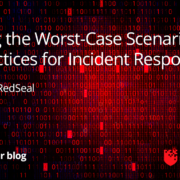Future-Proofing Your Security Infrastructure
Cybersecurity is getting more complicated every day. Why is this happening? Organizations are seeing their infrastructure becoming more complex, attack surfaces growing dramatically, and threats from cybercriminals evolving. What’s more, the reliance on public cloud, private cloud, hybrid cloud, and multi-cloud environments — coupled with more remote workers — has expanded the security perimeter for many organizations.
Even before COVID burst onto the scene, cybercrime was on the rise. Instead of a lone hacker sitting in a dark basement, contemporary cyber threat actors are part of organized crime rings.
All these trends underscore the importance of future-proofing your security infrastructure to combat major security threats and protect your mission-critical data.
Cyberattacks Are on the Rise: Data Tells the Tale
From Solar Winds to the Colonial Pipeline attack, cybercriminals have been making headlines in recent years. In addition, statistics reveal that cyberattacks are an ever-growing problem:
- A new ransomware attack is launched every two seconds
- Supply chain attacks have risen 42%, including a 564% increase in the number of individuals affected by data breaches
- More than 281.5 million people were affected by some type of data breach in a single year
- Data compromise is up 27%
Attacks are more prevalent, and they are getting more expensive. The average cost of a data breach now exceeds $4.2 million per incident and can cause recurring problems for years. On average, more than $2.9 million is lost to cybercrime every minute.
Despite increased spending on cybersecurity and best efforts by chief information security officers (CISOs) and information technology (IT) teams, nearly 80% of senior IT leaders believe their organizations lack sufficient protection against cyber-attacks. With the rising threat, every organization needs a strategy to future-proof its infrastructure.
What is Future-Proofing?
Future-proofing your cyber security creates a robust foundation that can evolve as your organization grows and new cyber threats emerge. This includes continually assessing your infrastructure for security gaps, proactively identifying threats, and remediating potential weaknesses.
Future-proof planning encompasses the totality of your security efforts. Failure to plan puts your entire organization at risk. You simply cannot afford to be left unprotected against current and future threats.
What Can (and Can’t) Be Future-Proofed within Your Technology Infrastructure?
What makes future-proofing technology challenging is that we don’t know exactly what the IT landscape will look like in the future. A few years ago, who knew we would see the explosion in the number of remote employees — often working on unprotected home networks.
The good news is that the cloud has given us tremendous flexibility and helps us future-proof without overspending right now on capacity we may or may not need. With nearly infinite scalability, cloud applications have allowed organizations to adapt and grow as necessary. However, it’s also put more sensitive and proprietary data online than ever before and made IT infrastructure more complex.
To future-proof your infrastructure, you need an approach for visualizing, monitoring, and managing security risks across every platform and connection. This lets you expand your security perimeter as your network grows and proactively identify new exposure as you evolve.
How Can Organizations Prepare for the Future?
Security needs to be part of every company’s DNA. Before you make any business decisions, you should run through security filters to ensure the right safeguards are in place. It takes a security culture that goes beyond the IT departments to future-proof your organization.
With data in the cloud, there’s a shared security responsibility. For example, public cloud providers take responsibility for their cloud security, but they are not responsible for your apps, servers, or data security. Too many companies are still relying on cloud providers to protect assets and abdicating their part of the shared security model.
Between multi-cloud, hybrid cloud environments, and a mix of cloud and on-prem applications, it’s become increasingly difficult to track and manage security across every platform. Many security tools only work in one of these environments, so piecing together solutions is also challenging.
For example, do you know the answers to these questions:
- What resources do we have across all our public cloud and on-premises environments?
- Are any of these resources unintentionally exposed to the internet?
- What access is possible within and between cloud and on-premises environments?
- Do our cloud deployments meet security best practices?
- How do we validate our cloud network segmentation policies?
- Are we remediating the riskiest vulnerabilities in the cloud first?
An in-depth visualization of the topology and hierarchy of your infrastructure can uncover vulnerabilities, identify exposure, and provide targeted remediation strategies.
You also need a cloud security solution to identify every resource connected to the internet. Whether you’re using AWS, Microsoft Azure, Google Cloud, Oracle Cloud, or other public cloud resources along with private cloud and on-prem resources, you need a holistic view of security.
Traditional security information and event management (SEIM) systems often produce a large volume of data, making it unwieldy to identify and isolate the highest priority concerns. You need a network model across all resources to accelerate network incident response and quickly locate any compromised device on the network.
Another necessity is continuous penetration tests to measure your state of readiness and re-evaluate your security posture. This helps future-proof your security as you add resources and new threats emerge.
Create a Secure Future for Your Organization
Creating a secure future for your organization is essential. As IT infrastructure and connectivity become more complex, attack surfaces continue to grow, and cybercriminals evolve their tactics, the risks are too great for your company, customers, and career not to build a secure foundation. You need to do more than plan your response to an incident and must know how to prevent cyberattacks with proactive security measures.
Secure all your network environments — public clouds, private clouds, and on-premises — in one comprehensive, dynamic visualization. That’s Red Seal.
RedSeal — through its cloud security solution and professional services — helps government agencies and Global 2000 companies measurably reduce their cyber risk by showing them what’s in all their network environments and where resources are exposed to the internet. RedSeal verifies that networks align with security best practices, validates network segmentation policies, and continuously monitors compliance with policies and regulations.
Contact Red Seal today to take a test drive.


